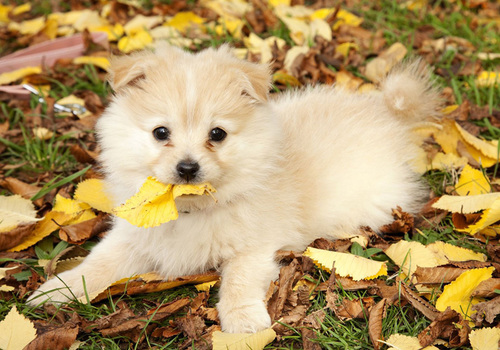Pomeranians have what is called a double coat. The undercoat is soft and dense; the outer coat is long and straight with a course texture.
Thanks to their small size, Pomeranians are easy to groom, even with all that coat. Brush the coat a few times a week to prevent mats or tangles. Use a medium to harsh slicker brush that will get down to the skin without hurting the dog.
You may have heard that Poms don’t shed. Forget that. They do. Luckily, they are small enough that the amount of hair they lose is negligible. If you brush your Pom regularly, shedding shouldn’t be a big issue.
Bathe a Pom every couple of months or more often as needed. If you use a gentle dog shampoo, you can even bathe a Pom as often as once or twice a week if you want.
The rest is basic care. Trim the toenails every week or two. They should never get long enough to clack on the floor. Brush teeth frequently with a vet-approved pet toothpaste for gooddental healthand fresh breath.
As much as Pomeranians enjoy being lapdogs and family companions, they do benefit from someexerciseand enjoy the chance to run, play, and go for walks. Be sure to keep a close eye on your Pom when he or she is outside.
They are notorious for escaping through small crevices or gaps in fencing, or climbing over short fencing. Small breeds like Pomeranians can be mistaken for rabbits or squirrels by large, predatory birds such as hawks and owls, so it is vital to keep a Pom undercover or stay with them at all times.
When taking your Pom for a walk, be cautious of your surroundings. Other dogs who are not controlled can easily hurt your Pom.
Pomeranians are known to be picky eaters, and since this breed needs to be fed dry dog food in order to prevent tooth loss, feeding them can be a problem. Try to stay away from table scraps – your Pomeranian will develop a taste for it and may ignore its dry food altogether.
They should do well on high-quality dog food, whether commercially manufactured or home-prepared with your veterinarian’s supervision and approval. Any diet should be appropriate to the dog’s age (puppy, adult, or senior).
Treatscan be an important aid in training, but giving too many can cause obesity. Learn about whichhuman foodsare safe for dogs, and which are not. Check with your vet if you have any concerns about your dog’s weight or diet.Clean, fresh water should be available at all times.
The average life span of the Pomeranian is 13 to 15 years. Breed health concerns may include collapsing trachea,hypothyroidism, elbow luxation, shoulder luxation, patellar luxation, hydrocephalus,entropion,cataracts, generalized progressive retinal atrophy,cryptorchidismandpatent ductus arteriosus.
The Pom should be trained to walk ona leashearly on and taught to comewhen called. Housebreaking can be a challenge, so consistency and patience are key. It is important to keep your Pom from jumping on and off couches or beds, as they can injure joints or even break a bone.
Since the breed is smart, your dog can be taught some amazing tricks. Like most dogs, crate training your Pomeranian is important, as it needs a den of its own.













